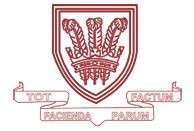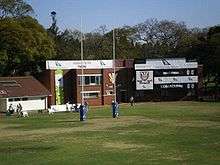Prince Edward School
| Prince Edward School | |
|---|---|
 Prince Edward School Badge Tot Facienda Parum Factum | |
| Location | |
|
Harare Zimbabwe | |
| Coordinates | 17°49′14″S 31°02′06″E / 17.8205°S 31.0350°ECoordinates: 17°49′14″S 31°02′06″E / 17.8205°S 31.0350°E |
| Information | |
| Type | Public, boarding and day school |
| Established | 13 June 1898 [1] |
| Sister school | Girls High School, Harare |
| Headmaster | Dr. Aggrippa G. Sora [2] |
| Gender | Male |
| Age | 13 to 19 |
| Number of students | 1200+ |
| Education system | Zimbabwean |
| Colour(s) | Green and Maroon |
| Mascot | Tigers |
| Alumni | Old Hararians |
| Website |
www |
Prince Edward School (or Prince Edward, commonly referred to as PE) is a public, boarding and day school for boys aged 13 to 19 in Harare, Zimbabwe. It provides education facilities to 1200+ boys in Forms I to VI. The school is served by a graduate staff of over 100 teachers.
Prince Edward School was ranked 6th out of the top 100 best high schools in Africa by Africa Almanac in 2003, based upon quality of education, student engagement, strength and activities of alumni, school profile, internet and news visibility.[3] Prince Edward School was also ranked as one of the Top 10 High Schools in Zimbabwe in 2014.[4]
History
Prince Edward was established in 1898 in Salisbury, Southern Rhodesia (now Harare, Zimbabwe) as Salisbury Grammar. The school is likely named for Edward VIII, who was Prince Edward at the time. It is the second oldest boys school in Harare and in Zimbabwe after its main sporting rival, St Georges' College.
The School's badge is a crown and three feathers, granted to it by Prince Edward (later King Edward VIII of the UK) in the 1920s. The school's colours are maroon and dark green. For its centenary, Prince Edward School adopted a new coat of arms which does not replace the school's badge. The motto of the school "Tot Facienda Parum Factum" ("So much to do, So little done") is attributed as Cecil John Rhodes' last words.
Name controversy
In 2002, before the March 2002 presidential elections, the Ministry of Education announced plans to change names of all government schools that had colonial connotations.[5] Scores of government schools were set to have their names changed to honour liberation war heroes, past national and African personalities and/or the suburban area in which the school is located. Prince Edward School was set to be renamed Murenga Boys High School after a Njelele high spirit said to have assisted the local heroes who fought the First Chimurenga of 1896-7. The change of names did not occur but in its wake, as a compromise, the Games Houses within the school had their colonial names changed to those of rivers in Zimbabwe.

Alumni
Prince Edward old boys are called "Old Hararians". The Old Hararians Association was founded in 1922 and maintains very close ties with the school.
The Old Hararians cricket team is based the Old Hararians Sports Club in Harare, and fields a team in the Vigne Cup, the Harare Metropolitan Cricket League, as well as the National League for club cricket. Old Hararians contain many national team and "A" team, such as Vusi Sibanda, Prosper Utseya and Ryan Butterworth.[6]
Notable alumni
- Tonderai Chavanga - plays for Western Province in South Africa
- Nick Price
- Mark McNulty
- Robert Gwaze
- Rodwell Makoto
- Graeme Cremer
- Duncan Fletcher
- Graeme Hick
- Trevor Penney
- David Houghton
- Eddo Brandes
- Mark Vermeulen
- David Mutendera
- Jackie du Preez
- Shingirai Muzondiwa Professional Tennis Player and Medical Doctor, 5 time Davis Cup player for Botswana www.daviscup.com
- David E. Potter - founder and chairman of the microcomputer systems company Psion PLC
- John Bredenkamp (probably the richest man in Zimbabwe with an estimated fortune of £720 million as indicated by the Sunday Times (UK));[7]
- Over the Edge - theatre troupe made up of old boys Lucien Wiina Msamati,Shaheen Jassat, Craig Peter, Zane E Lucas and Gavin Peter.
- Miles Anderson. Graduated with Honours from The Royal Academy of Dramatic Art. Has starred many times in London's West End notably as Bill Sikes in Oliver at the London Palladium. Spent 12 years with the Royal Shakespeare Co where he played Macbeth and in that time was the first male Peter Pan, he has 3 British Theatre Awards and an Olivier Nomination. He has recently received acclaim for his performance as George in The Madness of George The Third at The San Diego Theatre directed by Adrian Noble. His TV credits are numerous and include Ultimate Force, House of Cards, Soldier Soldier, Frost and The Waking the Dead.
- John Plagis, Southern Rhodesia's highest-scoring flying ace of World War II, as well as the conflict's top-scoring ace of Greek descent[8]
- Herbert Schwamborn- known under his artist name Metaphysics has gone to win major awards in Germany as a solo artist and also as a member of the multi-platinum band Söhnemannheims. He runs a record label based in Germany called Gandanga Music.
- Faustine Ndugulile, Tanzanian member of parliament
See also
References
- ↑ "Our History".
- ↑ "From the Headmaster".
- ↑ "top20highschools". Africa Almanac. Africa Almanac. 1 October 2003. Archived from the original on 14 January 2007. Retrieved 19 June 2016.
The research leading up to the publication of the 100 Best High Schools in Africa began with the launching of the website in December 2000.
- ↑ DarrylYV8 (9 October 2014). "Top 10 High Schools in Zimbabwe". Youth Village Zimbabwe. Youth Village Zimbabwe. Retrieved 5 January 2015.
- ↑ Government School names
- ↑ Brmtaylor.com list of club cricketers "Brendan Taylor - Zimbabwe Club Cricket Players"
- ↑ Sunday Times rich list 2002 Rich List in 2002
- ↑ Shores, Christopher F; Williams, Clive (1966). Aces High: the Fighter Aces of the British and Commonwealth Air Forces in World War II. London: Neville Spearman Publishing. p. 73. OCLC 654945475.; Charousis, Chariton (December 2010). Έλληνες Άσσοι σε Συμμαχικές Αεροπορίες κατά το Β΄ Παγκόσμιο Πόλεμο [Greek Aces in Allied Air Forces in World War II] (PDF). Aviation Review (in Greek). Athens: Hellenic Air Force: pp. 114–127. Retrieved 14 September 2013.; Who's Who of Southern Africa. Cape Town: Ken Donaldson. 1973. p. 1230. OCLC 1769850.